Published
on 3
Nov 2012
|
All rights reserved.
|
|
|
Having past 38 years
and sold over 29 million copies, Volkswagen Golf has entered the 7th
generation. If you line up all seven generations together, you will be
amazed with the subtleness and consistency of their evolutions. Their
design philosophies seem unaltered throughout the years – no-nonsense,
practical and a strong sense of solidity. A bit boring and lack of
progress they might look, the Golfs are more resistant to aging than
most contemporary rivals, and their sales success proved the approach
is
correct.
The Mk7 continues the evolutionary path. Its proportion is slightly
altered, being slightly longer (by 59 mm), wider (by 13mm) and lower
(by 28mm). The windscreen gets faster. The cabin is pushed rearward by
43 mm in relation to the front axle in an attempt to deliver a sportier
proportion matching BMW 1-Series and Mercedes A-class, though it is far
from successful. The blander nose, minimalist head/taillights and
straighter lines preferred by Walter de Silva highlight superior
assembly tolerance rather than aesthetic. Overall, the Mk7 does not
look as interesting as my favourite Mk5, though it does get more
aerodynamic efficient – Cd is reduced to a remarkable 0.27.
As I pointed out in the previous review, the outgoing Mk6 was not
really a new generation but actually a revamp of Mk5. This mean the
underpinning PQ35 platform is due for replacement in the Mk7. Taking
its place is MQB – a German term translating to "Modular Transverse
Matrix" – platform, already seen on Audi A3 and will soon apply to a
variety of Volkswagen, Skoda and Seat to come. It emphasizes on the
ability to adapt to different sizes and applications, from Polo to
Passat, including 4WD, hybrid and electric powertrains. This will
enhance the economy of scale thus reduce production costs and
development time further. The MQB also stresses on lightweight
construction. In the new Golf, the monocoque body employs a lot of
high-strength steel and hot-stamped steel to cut 23 kg while improving
rigidity and crash performance. Other areas see similar weight
reduction, such as engines (up to 40 kg), running
gears (up to 26 kg), seats (7 kg), air conditioning (2.7 kg) and
electrical system (6 kg). Volkswagen claims total weight saving is
up to 100 kg, although in most cases we found the actual weight saving
is between 20 and 70 kg when compare with the equivalent old models.
Another major change is the rear suspension. While most models continue
to employ multi-link setup, those with less than 120 hp are now served
with torsion-beam axle. Why? Volkswagen believes the cooking models
hardly need a sophisticated suspension, so it would rather save money
and weight by adopting the simpler torsion-beam setup. On the more
positive side, the new Golf introduces a couple of technologies for the
first time: adaptive damping and an integrated control
system (with Normal / Comfort / Sport mode to alter throttle, steering
and DSG gearshift). In this respect it sounds more like a premium
executive car.
As for engines, the Mk7 offers a mix of new and old engines. The
entry-level 1.2 TSI 8-valve petrol (85hp / 105 hp) is no stranger to
us. In contrast, the pair of 1.4 TSI engines comes from the new EA211
family. Improvements major on aluminum block, lighter moving parts,
integrated exhaust/turbocharger, integrated intake/intercooler,
improved cooling and the addition of dual-VVT. There are 2 states of
tune – 122 hp / 147 lbft and 140 hp / 184 lbft. The latter also
incorporates ACT cylinder deactivation system, which can shut down 2 of
the 4 cylinders under part load by means of zero-lift cam lobes (a
similar system is already used in Audi's 4.0-liter twin-turbo V8). This
engine is really impressive. It provides plenty of smooth power yet
returns an amazing 60 mpg (EU combined) and CO2
emission of only 109 g/km, easily putting it at the top of its class.
Moreover, the cylinder deactivation works seamlessly in an undetectable
manner. Refinement is especially impressive.
A little sad though, the 160 hp 1.4 Twincharger engine has been
discarded due to its high cost. If you want more performance, you have
to wait for the 220 hp GTi.
On the diesel side, both the 1.6 TDI and 2.0 TDI come from the new
EA288 family, although you might not notice. The smaller engine has its
output unchanged at 105 hp, while the larger unit is boosted by 10 hp
to 150 hp – still lagging behind some rivals. Their improvements lie in
the compatibility with EU6 emission and potential for upgrades in the
future.
Once entered the cabin, you will find a slightly more accommodating
environment. The wheelbase has been stretched by 56 mm to 2637 mm,
deliberating 15 mm of extra rear seat legroom. The wider cabin also
affords 30 mm extra shoulder room. In addition to a 380-liter boot – 30
liters more than before and has a larger opening for easier access –
the new Golf is highly practical.
However, what it really excels is build quality. This used to be the
strength of Golf, and it becomes even better. The dashboard layout is
now oriented to the driver and its design is slightly more stylish than
the past. Most surfaces are covered with expensive soft-touch plastics
– more than anyone else in the class with the exception of Audi A3
perhaps. All buttons are well damped and controls are well weighted.
Its attention to details is unrivaled. As before, the instrument is
clear and the rotary controls on center console is intuitive. A new
infotainment system provides an 8-inch touch screen with amazing image
clarity and easy to use menus. You can feel the tremendous effort spent
into its development. Meanwhile, the driving position is perfect,
thanks to vast range of adjustment. All-round visibility is good
despite of the chunky C-pillars.
On the road, the new Golf feels incredibly refined. At low to moderate
speed its engine noise is almost non-existent. Tire and suspension
noise are equally well insulated from the cabin. It sets new class
standards for cabin refinement. Ride quality is superb considering its
chassis setup is not overly biased towards the comfort side. Compare
with the previous generation, the Mk7 feels lighter, more agile, more
neutral and more resistant to roll. Its steering is slightly quicker
and more engaging, yet it becomes lighter at parking. It is
unquestionably more interesting to drive than sister car Audi A3,
although a Ford Focus or Alfa Giulietta might feel sportier.
Neither of these rivals provides a broad range of good engines and
excellent gearboxes like the Volkswagen best seller. They can't match
it for comfort, refinement and build quality, too. Therefore the new
Golf is once again the champion of the class – such a result is perhaps
as predictable as its new looks.
|
Verdict:      |
| Published
on 10
Jul
2013 |
All rights reserved.
|
|
Golf GTI
|
|
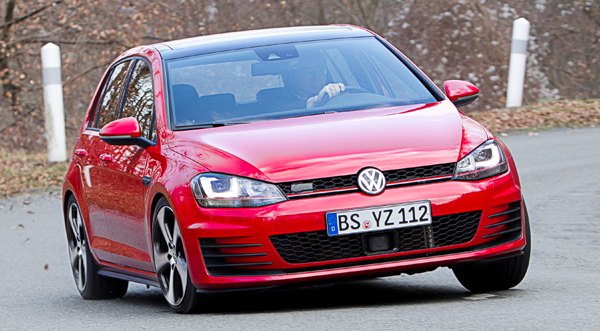
|
Despite of those mesh
grilles, extra louvers and 18-inch wheels, the new Golf GTI looks bland
I must say. It might be hotter than lesser Golfs, but parking beside a
Renault Megane RS265, Opel Astra OPC or even the new Mercedes A45 AMG
it looks hopelessly dull, just like a white appliance versus artistic
sculptures. You might say Golf GTI has always been conservative, but
this generation is even more so than the Mk6 and especially the
black-mask Mk5. The first impression is not very positive.
Get into the cabin, you may get the same feeling. New seats aside, it
doesn't feel a lot different from lesser Golfs. Yes, the material and
build quality is peerless (with the exception of sister car Audi S3).
The functionality and equipment (if you can afford) approaches the
level of executive cars. However, the maturity it displays is somewhat
irrelevant to the spirit of hot hatches, which should be fun and
exciting.
Open the bonnet, you will see the transverse engine is completely
hidden under black plastic covers. I still moan the death of Alfa 147
GTA, the last hot hatch that generously revealed its alloy cam covers
and chromed intake manifolds to your eyes. Anyway, time has changed and
now refinement and low emission occupy higher priorities. Like last
generation, the GTI is powered by the iron-block EA888 engine with
2-liter
capacity and a turbocharger. However, this is the 3rd generation and
many things have been improved. The block has been lightened; internal
friction has been reduced; the exhaust manifold is now integrated with
the cylinder head to improve cooling; on-demand cooling
and lubrication have been adopted. More significant upgrades include
dual-injection system (with stratified direct injection for part-load
and conventional port injection for high load) and adoption of Audi's
Valvelift 2-stage exhaust valve lift. It is hard to name the benefits
of individual changes, but the combined results are Euro-6 emission
compliance, 18-percent reduction of fuel consumption and a much
stronger torque output, rising from the previous 206 lbft to 258 lbft,
released from merely 1500 rpm to 4400 rpm. Meanwhile, maximum
horsepower inches up from 211 to 220, or if you opt for the Performance
package, to 230 hp. You might say not a big deal, but Car and Driver's
test results show a big difference in the real world – 0-60 mph
sprint is shortened from 6.3 to 5.6 seconds, while 0-100 mph is reduced
by 2 seconds to 14.2.
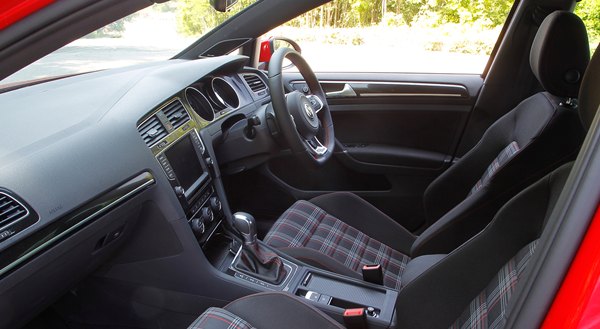
|
Despite of its inferior top end power, it matches Ford Focus ST in
straight line and trails Megane RS265 by a whisker. A45 AMG and M135i
are clearly out of its reach, but then the more powerful Golf R is on
the pipeline. What really surprises is how well it follows its more
powerful rivals when the roads get twisty, as Autocar discovered. The
Mk7 GTI is benefited from a lighter yet stiffer body shell and further
refinement to its MacPherson strut and multi-link suspensions as well
as adaptive dampers. On B-roads, it rides a lot smoother and quieter
than all rivals bar BMW. Not only Comfort and Normal modes, but Sport
mode also leaves enough compliance to be usable on normal roads. Such
an absorbent manner allows you to drive it faster than would be
otherwise possible on mountain roads. By the way, its engine smoothness
is also first rate among its four-cylinder rivals. This mean it is
easily the most comfortable to drive on day to day basis.
Meanwhile, the handling of the
new chassis is also much improved from the old car. It offers more
grip, more traction and less roll. The whole thing feels better tied
down and more agile. The new variable-ratio steering plays an
important role: its ratio progressively speeds up towards either sides,
resulting in only 2.1 turns from lock to lock. This sharpens the
handling in the twisty while keeping the car calm and refined at higher
speed. The electrical assistance is not as feelsome as Renaultsport's,
but its weighting and precision are beyond criticism.
The Performance model is even sharper, thanks to its new secret weapon
– an electronic-controlled limited slip differential! This Haldex-built
device is the first active LSD applied to a front-wheel-drive
production car. It uses a hydraulic-activated multi-plate clutch to
lock the differential progressively, resulting in a torque-vectoring
that is finer and smoother than those brake-based systems or mechanical
LSDs used by its rivals. It enables the car to cut understeer in corner
entry and oversteer in situations you don't want. No wonder the GTI
Performance shows a remarkably neutral and tidy handling. As the power
is better distributed, it also produces incredible traction and
front-end grip. Apart from the active LSD and the aforementioned power
boost, the Performance package brings larger ventilated disc brakes.
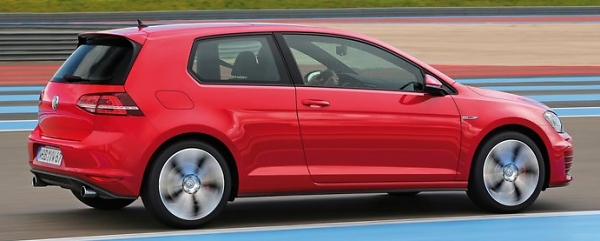
|
Ultimately, the Golf GTI is not as good a driver's car as Renaultsport,
because the latter's handling is sharper still, more fun and
more communicative. To certain extent, the Volkswagen falls victim to
its superior refinement. It is simply too calm, too tidy and the
exhaust note too quiet to inspire thrills.
As an everyday hot hatch, however, it is close to flawless. The only
rival standing in the way is BMW M135i. The
GTI's active differential gives it an edge over its rear-drive rival
with open differential, but the BMW strikes back with its creamy smooth
straight-six and stronger performance. Neither cars have the looks to
match their ingredients though. That said, no matter which one you
choose, you won't be disappointed.
|
Verdict:      |
| Published
on 12
Jul
2013 |
All rights reserved.
|
|
Golf GTD
|
|
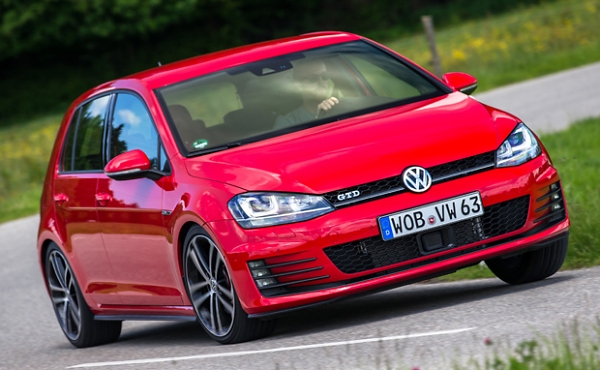
|
Since last generation,
Volkswagen uses the "GTD" badge to represent the diesel equivalent of
Golf GTI. In Mk7, the gap between GTD and GTI gets even smaller.
Visually, they are identical except the wheel design and the color of
the strip running across the front grille, i.e. red on GTI and chrome
on GTD. This mean on the street you will be hard pressed to identify
them without looking at the badges. Mechanically, they are also closely
matched. The GTD gets the same suspension modifications with 15 mm
lower ride height, stiffer springs and dampers, as well as the same
electronic adaptive dampers and driver control system. It employs the
same super-quick variable-ratio steering rack, the same 225/45R17 tires
and 312 mm ventilated front brake discs, although the rear ones are
smaller. It doesn't get the active LSD of GTI Performance, but like the
standard GTI it employs XDS+ virtual LSD, which uses soft braking and
ESP
sensors to implement torque vectoring with quite satisfying effect.
The main difference lies on the engine, of course. The GTD employs a
brand new EA288 2-liter 16V turbo diesel. Compare with the last
generation, it is improved in every way – lighter, with lower friction,
better cooling, increased common-rail fuel injection pressure and
addition of variable exhaust cam phasing (a first for diesel engines),
to name a few. The result is a maximum output increased from 170 to 184
hp, while peak torque improves from 258 to 280 pound-foot. By the way,
this is exactly the same engine fitted to Seat Leon FR 2.0TDI. The GTD
is capable to sprint from zero to 60 mph in just over 7 seconds and
flat out on Autobahn at 143 mph. Not as quick as the GTI, but
impressive for a diesel hatchback.
On the road, you will find the new engine a little smoother and freer
revving at the top end, although bear in mind this is still a diesel
engine. It runs out of steam above 4000 rpm, so it never thrills its
driver like the petrol GTI. Neither is it as responsive at the lower
end of the spectrum, as the power band is concentrated to the
mid-range. Use the slick 6-speed manual to keep it running in
mid-range, you will find it very quick. However, it is just not as
flexible or as eager as the GTI, nor its exhaust note as delicious to
ears, so the GTI is still clearly the choice of keen drivers.
Carrying an extra 26 kilograms, of which the majority is concentrated
at the nose, its handling is slightly less agile. The lack of
electronic LSD makes a big difference, too. Meanwhile, the ride is a
bit firmer, probably because the extra weight at the nose necessitates
stiffer springs. All in all, its chassis does not impress as much as
the petrol version.
So why do people want GTD? The answer is lower running costs. While it
is no
cheaper to purchase, its combined fuel consumption of 67 mpg and
emission level of 109 g/km should save a great deal of fuel bills and
taxes. This mean it should be a popular choice for company cars in
Europe. In fact, the GTD used to outsell GTI there. Expect the same
will happen on the new generation.
|
Verdict:     |
| Published on 14
May
2014 |
All rights reserved.
|
|
Golf R
|
|
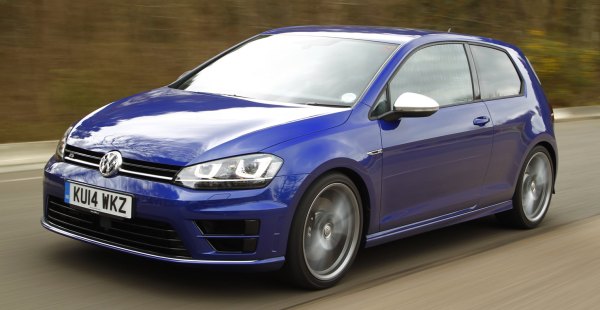
|
In the past few years the
hot hatch crown has been changing hands frequently. Long-time champion
Mitsubishi Lancer Evo is too long in the tooth so that it can no longer
fend off the competition from newer entries. This opens up
opportunities to the likes of Renault Megane RS265, BMW M135i and
Mercedes A45 AMG. All have their pros and cons thus none managed to
dominate the class as convincingly as the Evo did in the past decade.
The Megane was surely fun to drive and good to look at, but its
mediocre engine and performance figures leave something to be desired.
M135i, on the contrary, has a perfect powertrain combo but its soft
suspension, slightly numb steering and open differential hardly make it
the ultimate driving machine. The A45 AMG has tremendous performance
and all-wheel traction to beat anything else on the road from point A
to B, but its handling and ride shine only when you start pushing it
hard. Moreover, its steep price tag sets it apart from the rest of the
class. This mean, sooner or later it will be overshadowed. What we
didn't expect is how soon it comes…
The car that rolls over the current champion is Volkswagen Golf R. You
won't have guessed this from its civilized exterior design, which is no
more exciting than the lesser Golf GTI, let alone the highly stylish
A45 and Megane RS. You won't have guessed this from its bloodline
either.
Although Golf has long been renowned for GTI, its flagship R model has
never been seriously considered as class leader. The original Mk4 and
Mk5 Golf R32s were premium hot hatches powered by a classy VR6 and
driven by 4motion. They were unquestionably desirable but not in the
sense of driver's cars. In the last generation, the Golf R switched to
a high-power 2-liter turbo four-cylinder motor in the attempt to cut
fuel consumption and sharpen handling, though it still failed to
impress. The new car adopts the same strategy, but its execution is far
better.
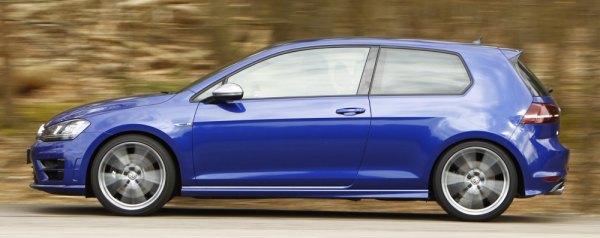 |
Based on the lightweight MQB platform, the new car has an inherent
advantage. It tips the scale at 1420 kg with standard Haldex 4WD system
and optional DSG gearbox fitted, undercutting the old car by 46 kg and
A45 by a valuable 60 kg. Much of this saving comes from the nose, so it
guarantees improved balance and agility. The new EA888 engine is
another major improvement. Compared with the one powering GTI, this
version gets a larger turbo and stronger components (cylinder head,
exhaust valves and pistons) in addition to the existing dual-variable
cam phasing, 2-stage variable exhaust valve lift and dual-mode direct
injection. Its output is lifted to a full 300 horsepower, while peak
torque is 280 lbft. The latter is delivered continuously from 1800 to
5500 rpm, guaranteeing a flexibility that shades the AMG engine.
Working in harmony with the excellent 6-speed DSG gearbox, the Golf R
is surprisingly quick against the stop watch – it accomplished 0-60 mph
sprint in only 4.5 seconds according to the test of German magazine
Auto Zeitung. 0-100 mph was done in an equally sensational 10.8
seconds. Such performance is the closest yet to the mighty AMG, if not
exactly there.
Strangely, on country roads where matter to hot hatches, the Golf R is
easier to drive fast than AMG. Its engine has less turbo lag to
overcome and its power delivery is smoother, allowing you to exploit
its performance more easily. Okay, the EA888 doesn't roar as lovely,
otherwise it would not have opted for sound synthesizer,
whose soundtrack mixes a Subaru flat-4 with a large-capacity V6 and
sounds too much artificial. Nevertheless, what it loses in sound
quality is more than made up with the faster, cleaner gearshifts of
DSG,
which is still the standard to judge.
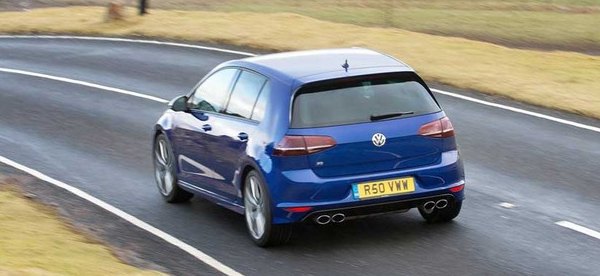
|
The Golf R also rides and handles brilliantly. Its suspension – stiffer
and 5 mm lower than that of Golf GTI – returns a pretty firm ride even
with adaptive dampers set to Comfort mode. To keen drivers, however,
this hardcore setup is beautifully judged. It brings a keenness and
accuracy not found on the GTI or even Mercedes. Compared with A45, the
Golf R usually feels lighter and more responsive to turn-in. It storms
through the twisty more fluently, with less body roll, brake dive or
initial understeer. In other words, it feels more agile and more tied
down. The variable-ratio steering is fast and accurate yet feeds you
with decent feel. There is no hint of torque steer, and with a linear
power delivery you can lean on the throttle earlier out of bend. Its
handling is so intuitive, so vice-free.
On the other hand, the 4WD gives it a decisive edge in handling when
compared with FWD rivals like Megane RS265 or Seat Leon Cupra 280. Mind
you, it is not a permanent 4WD system like the Japanese rally specials,
because the 4motion system implemented by Haldex multi-plate clutch
sends power to the rear axle only when the front wheels start slipping.
However, the 5th generation Haldex system gets more responsive than
before, helping the Golf R to display remarkably little understeer. Its
limit is now so high that you can rarely feel the understeer driving on
public roads. When you push it really hard, you can sense a hint of
understeer, which is then quickly followed by a stabilizing power
transfer to the rear wheels. Surprisingly, there is even some throttle
adjustability to play with on looser surfaces. Lift off mid-corner and
its nose tuck in. Get back on throttle aggressively and you can push it
into a 4-wheel drift – admittedly not in the extent of Evo or STI but
this is rare in the field of front-biased 4WD cars. As a result, the
Golf R is fun to drive.
For sheer driver engagement it still cannot quite match the highly
interactive Megane, but the super Golf outclasses the latter in many
other performance aspects. It is also the more usable, the more
sophisticated and higher quality car. Only the dull look might drive
off buyers.
|
Verdict:      |
| Published
on 4
Sep
2014 |
All rights reserved.
|
|
Golf GTE
|
|
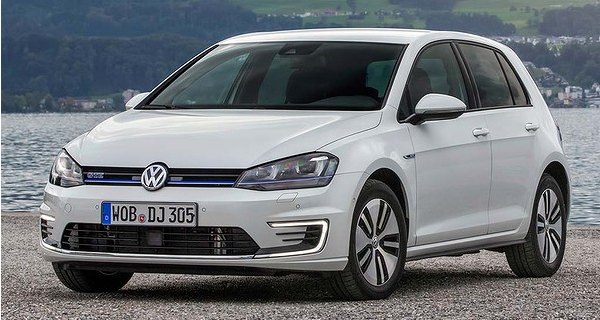
|
One remarkable thing about
Volkswagen’s MQB platform is its compatibility with electrification.
This allows the introduction of pure electric e-Golf as well as plug-in
hybrid Golf GTE. I will cover the former at a later date, but now let’s
look at the GTE.
As implied by its name, the GTE is the electric version of GTI (just
like GTD representing the diesel version of GTI) thus it is a rare
performance hybrid on the market. Some of its underpinnings, like the
stiffer suspensions and faster steering, come from the GTI, but the
powertrain is not, of course. It comprises of a 150 hp 1.4 TSI engine
and a synchronous motor with maximum output of 102 hp and 243 lbft. The
latter is installed close to the 6-speed DSG gearbox, which has been
modified to allow the engagement and disengagement of either power
sources. The addition of e-motor could have made the car more
nose-heavy, but this is counterbalanced by putting the 120 kg, 8.8 kWh
lithium-ion battery pack under the rear seats. To make space for the
battery, the fuel tank is made smaller (no problem as fuel economy is
greatly enhanced by the hybrid system) and relocated to aft of the rear
axle, i.e. under the boot floor. Inevitably, luggage space suffers as a
result, reducing from 380 to only 272 liters. That loss of luggage
space and the weight gain of 200 or so kilograms are the most obvious
drawbacks of the hybrid conversion.
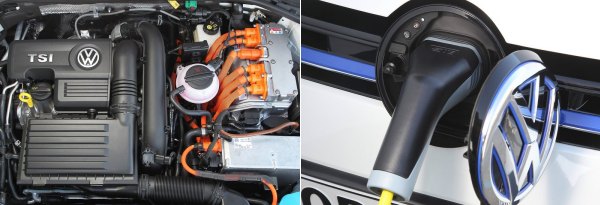
|
With both engine and motor working, total system output is 204 hp and
258 lbft – the latter is deliberately reduced to avoid overloading the
DSG gearbox. That nearly matches the standard GTI. The weight penalty
means it is inevitably slower against the clock – 0-60 mph sprint is
quoted at 7.2 seconds, a full second adrift of the GTI – but in the
real world it feels faster than it is, thanks to the instant stream of
electric torque available from very low rpm. As expected for German
engineering, the powertrain integration is excellent, with smooth and
nearly imperceptible transition between petrol and electric power.
The extra weight does not hurt its handling as much as expected,
perhaps owing to the low placement of battery. Mind you, it is not as
agile as the GTI, but it offers solid roadholding and braking, while
steering is quick and consistent.
Undoubtedly, the best part is fuel economy. If you charge it full at
home, which takes less than 2 hours with 240V 16A socket, you may be
able to see it travel up to 50 km in zero emission mode. The combined
fuel consumption figure of 188 mpg might be a bit exaggerating, as is
the CO2 emission of 35 grams per km, but
in the real world it should guarantee better figures than any diesel
Golfs, let alone any hot hatches. So this is the first time hot hatch
drivers don’t need to sacrifice the pursuit of green motoring. The only
price they have to pay is a higher price – about 10 percent more than
the GTI. That’s very reasonable, thanks to the flexible MQB platform.
|
Verdict:     |
| Published
on 20
Sep
2014 |
All rights reserved.
|
|
e-Golf
|
|
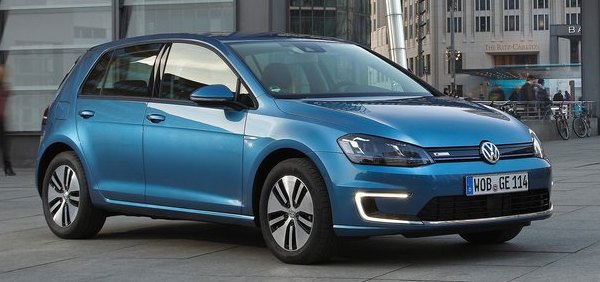
|
Until now, electric cars
are either dedicated designs or heavily modified from conventional
cars. The e-Golf is the first electric car to be integrated into the
production car program, being part of the Golf family. It is built on
the same production line as the petrol and diesel Golfs. This is made
possible by taking it into account at the earliest planning stage of
the MQB platform.
Technology-wise, the e-Golf makes no breakthrough. Its synchronous
motor produces 115 hp and 199 lbft of torque and sits in the engine
compartment together with the single-speed gearbox and inverter/power
control module. 24.2kWh of lithium-ion battery cells are packed under
the front seats, transmission tunnel and rear seats, taking place of
fuel tank. Its top speed is limited to 87 mph (140 km/h) to conserve
battery. 0-60 mph acceleration is done just under 10 seconds, slightly
quicker than a Nissan Leaf but no match for BMW i3. Depending on load
and driving style, its travelling range is between 80 and 120 miles,
slightly longer than the aforementioned rivals.
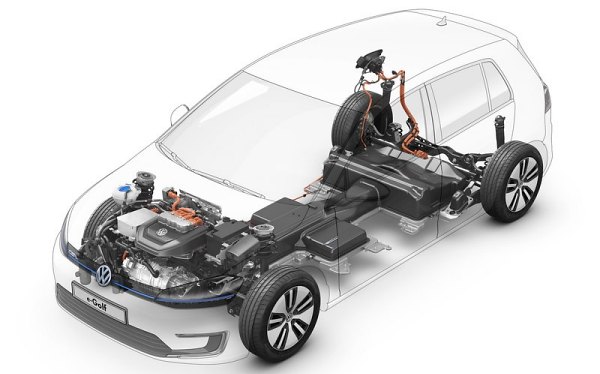
|
Ridiculously, what makes it special is how ordinary it looks and works.
The e-Golf feels every bit as good as a Golf, no matter the build
quality, refinement or usability. It also drives remarkably close to a
diesel Golf. The electric motor is as smooth and torquey as expected.
Powertrain noise is all but non-existent. Wind and road noises are well
suppressed. The extra weight of batteries means it is at least 200 kg
heavier than the diesel models, but it doesn’t feel as heavy in
corners. In fact, it steers, grips and controls its body movement as
good as other Golfs. The only noticeable difference is a slightly
harsher ride, as its ride height is lowered to reduce frontal area
hence drag.
To some drivers fancy with the idea of electric cars, the e-Golf might
be too ordinary to be desirable. They are more likely to opt for the
similarly-priced BMW i3. However, from functions point of view this car
is probably the better, as it is more spacious, more comfortable, more
reliable and more normal to drive. Electric cars have never come with
so few compromises.
|
Verdict:     |
| Published
on 6
Jun
2016 |
All rights reserved.
|
|
Golf GTI Clubsport
|
|
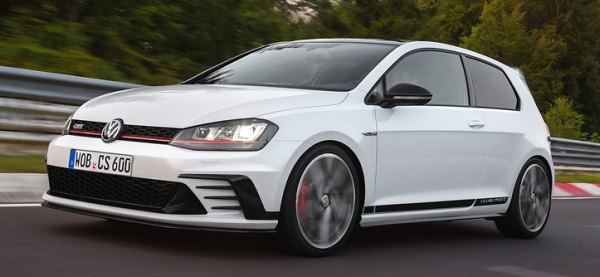
|
To mark the 40th
anniversary of Golf GTI, Volkswagen built this GTI Clubsport. Unlike
the previous ED25, ED30 and ED35, it is an
unlimited production model offered alongside the base GTI and GTI
Performance. You can distinguish the car by its more pronounced air
dam, skirts and the black rear spoiler extension. They successfully
turn the aerodynamic lift to a slightly positive downforce at both
axles. Inside, the cabin gets good-looking Recaro bucket seats and
Alcantara trims to lift desirability even further. On the downside,
this car is priced almost the same as the range-topping Golf R.
Unfortunately, its technical spec. is more a highly tuned GTI
Performance than the equivalent of Golf R. The EA888 engine is tuned
halfway between those cars, delivering 265 horsepower and 258 lbft of
torque, although it provides an overboost to 290 hp and 280 lbft for up
to 10 seconds. In contrast, a Seat Leon Cupra offers the same peak
power and torque anytime you like. Moreover, the overboost is available
only when the gearbox is at 3rd or above, seems like its
front-wheel-drive hardware and electronic-controlled LSD have problems
to tame the extra power. You can easily feel the stronger punch in
straight line acceleration, but it can’t quite match the speed of Golf
R and Leon Cupra.
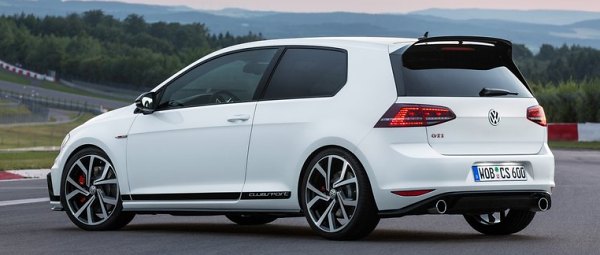
|
At the chassis, Volkswagen dialed up its springs by 10 percent and
retuned the adaptive dampers. Since the change is hardly dramatic, its
ride remains very composed thus day-to-day usability remains peerless.
Does it resist g-force stronger? It’s hard to tell, but the car does
balance better, cornering with a more neutral attitude, primarily
because the extra downforce allows Volkswagen to scale back the
understeer built into its chassis without risking high-speed stability.
Another noticeable improvement is the set of optional Michelin PS Cup 2
tires on 19-inch rims. They generate much stronger grip on dry roads,
enabling aggressive cornering and sharper turn-in. Ultimately, it is
still
not quite as sharp or adjustable as Renault Megane RS275 Trophy, or as
fast as Honda Civic Type R. Its steering feel and braking power have
room for improvement, too. Most of these problems could be sorted out
by the hotter Clubsport S which set new class record at Nurburgring
recently, but that will be another story...
As a whole, the Clubsport is very expensive for the performance it
offers. Golf R is not only more versatile but it remains the best
performance Golf by some margin.
|
Verdict:     |
| Published
on 11
Jun
2016 |
All rights reserved.
|
|
Golf GTI Clubsport S
|
|
The title of "the
fastest front-wheel-drive car in Nurburgring" has changed hands a few
times since Seat Leon Cupra broke the 8-minute barrier in 2014. The
specially prepared Leon (available as road car later) set a record at 7
min 58.4 sec that year. Soon afterwards, Renault Megane RS275 Trophy-R
lifted the bar to 7 min 54.4 sec. In 2015, Honda Civic Type R rewrote
the record to 7 min 50.6 sec. Now its laurel is taken over by
Volkswagen Golf GTi Clubsport S, which is the extreme version of
Clubsport. It set a new record at 7 min 49.2 sec recently. Who knows
how long it can stand?
As usual, the key to record breaking pace is the combination of more
power and less weight. The GTi Clubsport S gets the most powerful
version of EA888 2.0 TSI engine available in the group, i.e. the 310 hp
/ 280 lbft version already seen on Audi TT S. That makes it 10 ponies
more than even the Golf R. Its chief difference from the Golf R engine
is larger exhaust, which also produces angrier noises. To save weight,
the engine is mated to 6-speed manual gearbox instead of DSG, even
though that might rob it a couple of tenths of a second in 0-60 mph
sprint.
The DSG would have added 20 kg. As it is not used, the car tips the
scale at only 1285 kg, 30 kg lighter than the production GTi Clubsport
or 116 kg less than the 4-wheel-drive Golf R. In other words, it is the
lightest member of the Golf GTi family. Weight saving goes as far as
ditching the rear seats (yes, it's strictly a 2-seater), air
conditioning (it becomes a no-cost option), some sound deadening
materials, carpets, the parcel shelf and adjustable floor in the boot.
Besides, aluminum front suspension subframe, aluminum-hub brake discs
and lighter alloy wheels also shed some weight.
The rest of the car is about the same as the Clubsport. It has VAQ
active LSD to help distributing torque between the front wheels in hard
cornering. It is shod with sticky Michelin PS Cup 2 tires. Adaptive
damping and DCC driver control remain, but the latter gets an extra
Individual mode to allow customizing the steering, throttle response,
ESP and suspension. The default setting of Individual is tuned
specially for Nurburgring, which means soft suspension setting to
absorb the notorious bumps at Nurburgring while everything else is set
to Race mode. Another important modification is a pair of new aluminum
knuckles at the front suspension. It increases negative camber to
enhance grip and reduce understeer at hard cornering. Outside, the
Clubsport’s aerodynamic package is retained, which means a slight
positive downforce can be generated at high speed.
Inevitably, the lack of 4-wheel-drive means the Clubsport S cannot
match 4WD rivals like Golf R, Ford Focus RS, Mercedes A45 and Audi RS3
for standing start acceleration. It takes about 5.5 seconds to go from
rest to 60 mph, about the same as Megane RS275 Trophy R and Honda Civic
Type R. Without employing speed limiter, the Golf can top 164 mph. This
should be the ultimate hot Golf as the 400-horsepower R400 has been
cancelled amid dieselgate crisis. Its price and rarity also reflect
this top status: £35,000 and 400 units only.
On the road, the Clubsport S feels very different from Clubsport. Its
engine is more energetic, revving cleanly to 6800 rpm redline yet
without losing low-end response. The exhaust note is louder and
sportier but never intrusively so, very well judged. The manual
gearshift is quick and tight, better than most rivals. Enter a corner,
the car turns in more sharply, obviously due to the revised suspension
geometry and reduced weight. The steering feels sharper, too. With VAQ
and the racy Michelins Cup tires, it affords tremendous front-end grip
and traction, yet the steering does not suffer from torque steer or
corruption in feel, how can it be possible? The chassis balance is
close to neutral, with a touch more understeer than Megane at the
limit. You can tuck its nose back to line if you lift off throttle
mid-corner, but the degree is more subtle than the Megane – its
multi-link suspension keeps the tail more tied down than the
torsion-beam arrangement of Renault. This means, the Volkswagen is not
as entertaining as a track weapon, but it is easier and safer to drive
fast.
However, the most impressive is how effortlessly its more sophisticated
suspension absorbs nasty bumps on back roads and kerbs in Nurburgring.
The superior composure it shows is the main reason why it can do a
better Nurburgring lap time. Renault is not far behind in this respect
(especially with Ohlins dampers), but Civic Type R is far more brutal
in comparison. In fact, despite the weight savings, the Clubsport S
keeps most of the traditional Volkswagen merits, including low noise
level and high build quality. It is as good a useable road car as it is
a lap record breaker. It’s a shame it has no rear seats, which
effectively rules it out of the hot hatch class. In addition to the
high price, the cheaper and more versatile Golf R is still a better bet.
|
Verdict:     |
Published
on 23
Jan 2019
|
All rights reserved.
|
|
Golf GTI TCR
|
|
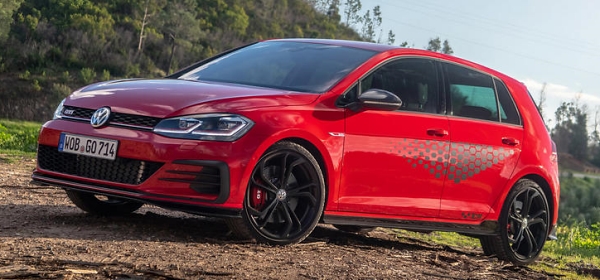
|
|
Fastest
FWD Golf can't quite match its spiritual predecessor, Clubsport S.
|
|
Huge
wings and air dam, massively widened wheel arches, an engine boosted to
350hp, sequential gearbox, full roll-cage, adjustable dampers and
anti-roll bars, digital instrument with data logger, stripped out
interior… well, what I am describing is the Golf GTI TCR racer, a car
built to the specifications of FIA’s Touring Car Racing category. Too
hardcore for you? A more relevant alternative is the TCR road car shown
here. Mind you, it is linked to the racer just by name. Everything is
built on the stock GTI Performance, or you might see it as a slightly
toned down version of the late Clubsport S, a limited edition that we
loved so much. Unlike the Clubsport S, the GTI TCR is a production
model with unlimited supply, at least unlimited until the current Golf
Mk7 vanishes this summer.
In terms of market positioning, the TCR sits above all fast Golfs
except the 4-wheel-drive Golf R. Like the Clubsport S, it keeps
front-wheel-drive to make it lighter and its driving experience more
transparent than the Golf R, but things are not quite as hardcore or as
simple as the Clubsport S. Its suspension setup is slightly softer.
Michelin Cup 2 tires are moved to the option list. Its engine is
retuned for more low-end torque but sacrifices 20hp at the top (partly
due to WLTP testing procedure, admittedly), now rated at 290hp. But
most telling, it employs 7-speed DSG instead of good old manual. All in
the name of making the TCR more road-relevant, claimed its engineers.
However, a list price of £34,000 is not that relevant to most
buyers. It is 10 percent more expensive than the Golf R, which has 4WD
as well as 10 more horsepower. At 4.7 versus 5.3 seconds, the Golf R
also beats the TCR convincingly in 0-60 mph sprint. Why do you want
this slower, less sophisticated yet more expensive kind of fast Golf?
If it drove as good as the late Clubsport S, it might be worth that
kind of cash. However, as it is not quite as hardcore, its driving
experience is not as memorable as well. The Clubsport S could be so
exciting to drive because it got extreme weight saving (losing sound
insulation and even the rear seats) as well as new aluminum front
suspension knuckles for more negative camber. The TCR is closer to the
specifications of the lesser GTI Performance, just gets 5mm lower and
slightly stiffer suspension, while geometry is unchanged. This explains
why it does not feel as agile or as sharp to turn-in. In return, it is
calmer and more relaxing to track straight on highway. Its ride might
be a tad more comfortable, and its cabin retains the high standard of
noise insulation of other Golfs. Yes, as a daily driver, the TCR is
easier to live with, but you can always say the same to the Golf R, or
even the regular GTI Performance. Without dialing the excitement factor
to maximum, there is no reason to justify its creation. Don’t get me
wrong, the TCR is still a fast and competent hot hatch. Problem is, it
is overpriced by £5,000 and surrounded by plenty of good fast
Golfs.
|
Verdict:     |
|